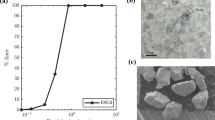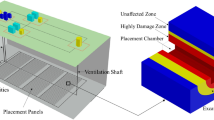Abstract
Changes of morphological parameters of oil shale under thermal conditions are investigated. Analyses are based on 26 micro-computed tomography (micro-CT) images of Green River immature shale rock available under creative commons license. Several image processing and characterization algorithms are applied to sequential high-resolution micro-CT images of oil shale samples undergoing pyrolysis. Pore-scale morphology is extracted and quantified, providing results for pore size, throat size, grain size, specific surface, coordination number, and fracture aperture. The results demonstrate critical increases of porosity, coordination number and fracture aperture in the temperature range from 390 to 400 \({^{\circ }}\hbox {C}\), which translates into step change in the transport properties of the shale after pyrolysis. It is further observed that the coordination spectrum, the pore and throat size distributions, become smoother during the pyrolysis process. Finally, the absolute permeability of the samples is calculated at each step in three principal directions, and it is demonstrated that samples’ permeability is more correlated with the pore connectivity rather than the average pore size. The morphological characteristics presented here enable advanced microstructure-informed approaches to pore-scale modeling of transport for optimizing oil production.




















Similar content being viewed by others
References
Akkutlu, I.Y., Fathi, E.: Multiscale gas transport in shales with local kerogen heterogeneities. SPE J. 17(04), 1–002 (2012)
Baldwin, C.A., Sederman, A.J., Mantle, M.D., Alexander, P., Gladden, L.F.: Determination and characterization of the structure of a pore space from 3D volume images. J Colloid Interface Sci. 181(1), 79–92 (1996)
Bin, B., Rukai, Z., Songtao, W., Wenjing, Y.A.N.G., Gelb, J., Gu, A., Ling, S.U.: Multi-scale method of nano (micro)-CT study on microscopic pore structure of tight sandstone of yanchang formation, ordos basin. Pet. Explor. Dev. 40(3), 354–358 (2013)
Collins, R.E.: Flow of fluids through porous materials. PennWell Publiashing Co., Tulsa (1961)
Curtis, M.E., Sondergeld, C.H., Ambrose, R.J., Rai, C.S.: Microstructural investigation of gas shales in two and three dimensions using nanometer-scale resolution imaging. AAPG Bull. 96(4), 665–677 (2012)
Dullien, F.A.: Porous media: fluid transport and pore structure. Harcourt Brace Jovanovich Publishers, San Diego (1991)
González-García, R., Monje, F.: The reliability of cone-beam computed tomography to assess bone density at dental implant recipient sites: a histomorphometric analysis by micro-CT. Clin. Oral Implant. Res. 24(8), 871–879 (2013)
Harwood, R.J.: Oil and gas generation by laboratory pyrolysis of kerogen. AAPG Bull. 61(12), 2082–2102 (1977)
Hughes, R.G., Blunt, M.J.: Network modeling of multiphase flow in fractures. Adv. Water Res. 24(3), 409–421 (2001)
Jacquet, J.B.: Review of risks to communities from shale energy development. Environ. Sci. Technol. 48(15), 8321–8333 (2014)
Jivkov, A.P., Xiong, Q.: A network model for diffusion in media with partially resolvable pore space characteristics. Transp. Porous Media 105, 83–104 (2014)
Johns, R.A., Steude, J.S., Castanier, L.M., Roberts, P.V.: Nondestructive measurements of fracture aperture in crystalline rock cores using X ray computed tomography. J. Geophys. Res.: Solid Earth 98(B2), 1889–1900 (1993)
Mayo, S., Josh, M., Nesterets, Y., Esteban, L., Pervukhina, M., Clennell, M.B., Maksimenko, A., Hall, C.: Quantitative micro-porosity characterization using synchrotron micro-CT and xenon K-edge subtraction in sandstones, carbonates, shales and coal. Fuel 154, 167–173 (2015)
McCabe, W.L.: Unit Operations of Chemical Engineering, 7th edn. MC. Graw Hill, New York (2005)
Mehrabi, M., Pasha, M., Jia, X., Hassanpour, A.: Pore volume analysis of gas shale samples using 3-D X-ray micro tomography. In: SPE Offshore Europe Conference and Exhibition, Society of Petroleum Engineers, SPE-175442-MS, Aberdeen, Scotland, UK (2015)
Pan, Z., Feng, H.Y., Smith, J.M.: Rates of pyrolysis of Colorado oil shale. AIChE J. 31(5), 721–728 (1985)
Pan, L., Dai, F., Huang, J., Liu, S., Li, G.: Study of the effect of mineral matters on the thermal decomposition of Jimsar oil shale using TG-MS. Thermochim. Acta 627, 31–38 (2016)
Rabbani, A., Ayatollahi, S.: Comparing three image processing algorithms to estimate the grain-size distribution of porous rocks from binary 2D images and sensitivity analysis of the grain overlapping degree. Spec. Top. Rev. Porous Media 6(1), 71–89 (2015)
Rabbani, A., Jamshidi, S.: Specific surface and porosity relationship for sandstones for prediction of permeability. Int. J. Rock Mech. Min. Sci. 71, 25–32 (2014)
Rabbani, A., Jamshidi, S., Salehi, S.: Determination of specific surface of rock grains by 2D imaging. J. Geol. Res. 71, 25–32 (2014a)
Rabbani, A., Jamshidi, S., Salehi, S.: An automated simple algorithm for realistic pore network extraction from micro-tomography images. J. Pet. Sci. Eng. 123, 164–171 (2014b)
Rabbani, A., Ayatollahi, S., Kharrat, R., Dashti, N.: Estimation of 3-D pore network coordination number of rocks from watershed segmentation of a single 2-D image. Adv. Water Resour. 94, 264–277 (2016)
Raeini, A.Q., Blunt, M.J., Bijeljic, B.: Direct simulations of two-phase flow on micro-CT images of porous media and upscaling of pore-scale forces. Adv. Water Resour. 74, 116–126 (2014)
Saif, T., Lin, Q.: Oil shale pyrolysis. Imperial college consortium on pore-scale modelling, 2 Jul 2016. https://dx.doi.org/10.6084/m9.figshare.3406483.v1
Saif, T., Lin, Q., Singh, K., Bijeljic, B., Blunt, M.J.: Dynamic imaging of oil shale pyrolysis using synchrotron x-ray micro-tomography. Geophys. Res. Lett. 43(13), 6799–6807 (2016)
Salem, H.S., Chilingarian, G.V.: Determination of specific surface area and mean grain size from well-log data and their influence on the physical behavior of offshore reservoirs. J. Pet. Sci. Eng. 22(4), 241–252 (1999)
Sheppard, A.P., Sok, R.M., Averdunk, H.: Improved pore network extraction methods. In: International Symposium of the Society of Core Analysts, vol. 2125. Toronto, Canada (2005)
Sutera, S.P., Skalak, R.: The history of Poiseuille’s law. Ann. Rev. Fluid Mech. 25(1), 1–20 (1993)
Van Geet, M., Swennen, R.: Quantitative 3D-fracture analysis by means of microfocus X-Ray computer tomography \((\upmu \text{ CT })\): an example from coal. Geophys. Res. Lett. 28(17), 3333–3336 (2001)
Walls, J.D., Sinclair, S.W.: Eagle ford shale reservoir properties from digital rock physics. First Break 29(6), 97–101 (2011)
Wei, Z., Na, M., Huisheng, S., Hongqi, F.: Feature extraction of X-ray fracture image and fracture classification. Artif. Intell. Comput. Intell. 2, 408–412 (2009)
Wildenschild, D., Sheppard, A.P.: X-ray imaging and analysis techniques for quantifying pore-scale structure and processes in subsurface porous medium systems. Adv. Water Res. 51, 217–246 (2013)
Willemink, M.J., Leiner, T., de Jong, P.A., de Heer, L.M., Nievelstein, R.A., Schilham, A.M., Budde, R.P.: Iterative reconstruction techniques for computed tomography part 2: initial results in dose reduction and image quality. Eur. Radiol. 23(6), 1632–1642 (2013)
Willemink, M.J., de Jong, P.A., Leiner, T., de Heer, L.M., Nievelstein, R.A., Budde, R.P., Schilham, A.M.: Iterative reconstruction techniques for computed tomography part 1: technical principles. Eur. Radiol. 23(6), 1623–1631 (2013)
Xiong, Q., Jivkov, A.P., Yates, J.R.: Discrete modelling of contaminant diffusion in porous media with sorption. Microporous Mesoporous Mater. 185, 51–60 (2014)
Xue-gui, S., Xian-jie, D., Hong-hu, Y., Ben-kui, L.: Research of the thermal stability of structure of resin anchoring material based on 3D CT. Int. J. Adhes. Adhes. 68, 161–168 (2016)
Yan, J., Jiang, X., Han, X., Liu, J.: A TG-FTIR investigation to the catalytic effect of mineral matrix in oil shale on the pyrolysis and combustion of kerogen. Fuel 104, 307–317 (2013)
Zhao, J., Yang, D., Kang, Z., Feng, Z.: A micro-CT study of changes in the internal structure of Daqing and Yan’an oil shales at high temperatures. Oil Shale 29(4), 357–367 (2012)
Author information
Authors and Affiliations
Corresponding author
Rights and permissions
About this article
Cite this article
Rabbani, A., Baychev, T.G., Ayatollahi, S. et al. Evolution of Pore-Scale Morphology of Oil Shale During Pyrolysis: A Quantitative Analysis. Transp Porous Med 119, 143–162 (2017). https://doi.org/10.1007/s11242-017-0877-1
Received:
Accepted:
Published:
Issue Date:
DOI: https://doi.org/10.1007/s11242-017-0877-1




